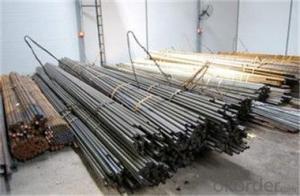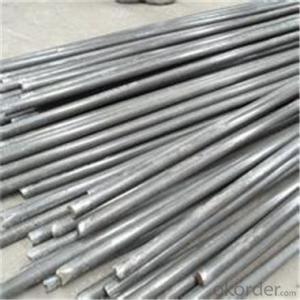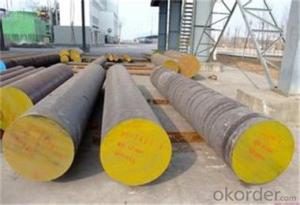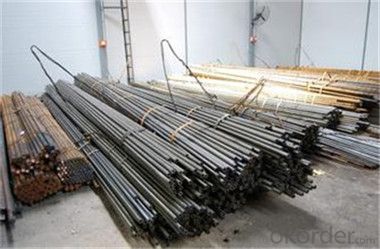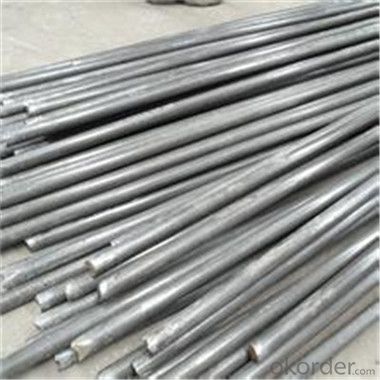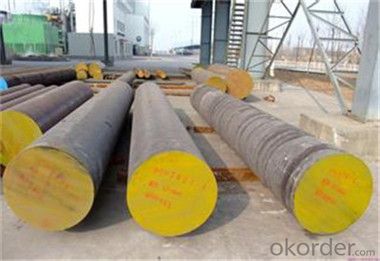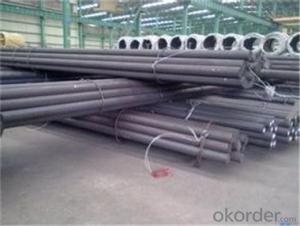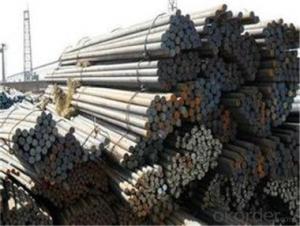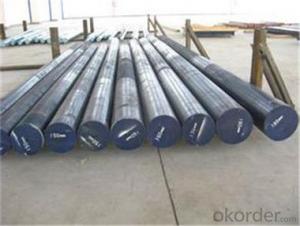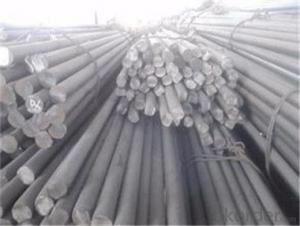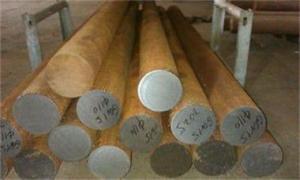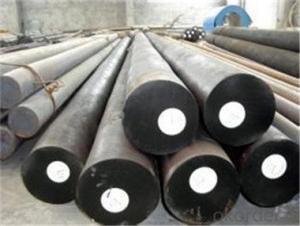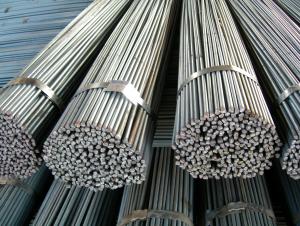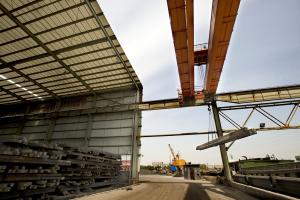Hard Chrome Carbon Steel Round Bar in CNBM
- Loading Port:
- Shanghai
- Payment Terms:
- TT OR LC
- Min Order Qty:
- 8900 m.t.
- Supply Capability:
- 200008888 m.t./month
OKorder Service Pledge
OKorder Financial Service
You Might Also Like
Description of steel round bar:
1.Diameter 80 to 800 mm
2.Black or Bright surface
Festures of steel round bar:
4340 Forged Round Steel Bar Dia 80-800mm Length:2000-13000mm or as required
Specifications of steel round bar:
Description |
Carbon Steel Rod/Carbon Steel Bar,carboteel bar | |
Material | ASTM | 1005,1006,1008,1010,10 |
DIN | Ck10,Ck15,Ck22,Ck25,Ck30,Ck35,Ck40,Ck45,Ck50, 30Mn4,40Mn4 | |
BS | 040A04,095M15,045M10 | |
Standard | GB/T799,ASTM A29,A108,A321,A575 | |
Section shape |
Round | |
Length |
As your required | |
Application | Carbon steel rod applies to chemical industry,electric power, pump shafts, sanitary wares,furniture handles,boiler,high temperature resistant,low temperature resistant, corrosion resistant. | |
Images of steel round bar:
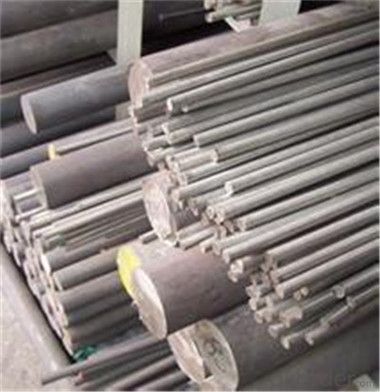
FAQ:
1. What is your package?
Packing situation: standard seaworthy packing or as customer required.
2. How long is the lead time?
Delivery time: 60 days after order confirmed.
- Q: What is the resistance to fatigue of a steel round bar?
- The resistance to fatigue of a steel round bar refers to its ability to withstand repeated loading and unloading cycles without experiencing failure or deformation. Fatigue resistance is an essential mechanical property for materials used in various applications, including structural components, machinery, and automotive parts. The resistance to fatigue of a steel round bar depends on several factors, including the specific grade of steel, its microstructure, surface condition, and the applied loading conditions. Steel is generally known for its excellent fatigue resistance compared to other materials, which is one of the reasons for its widespread use in various industries. Steel's resistance to fatigue can be attributed to its high strength, ductility, and the presence of various alloying elements. These factors allow steel to withstand cyclic loading without undergoing significant deformation or weakening. Additionally, the microstructure of the steel, such as grain size and distribution, also plays a crucial role in determining its fatigue resistance. To evaluate the fatigue resistance of a steel round bar, engineers typically perform fatigue tests, such as the rotating beam or axial loading tests. These tests involve subjecting the steel bar to controlled cyclic loading and measuring the number of cycles it can withstand before failure occurs. The results of these tests are used to determine the fatigue strength or fatigue limit of the steel, which represents the maximum stress level it can endure indefinitely without failure. It is important to note that the fatigue resistance of a steel round bar can vary depending on factors such as surface defects, stress concentration, and environmental conditions. Therefore, proper design considerations, such as surface treatments, stress reduction techniques, and appropriate loading specifications, are essential to ensure the desired fatigue performance of the steel round bar in specific applications.
- Q: What are the advantages of using bearing steel round bars?
- There are several advantages of using bearing steel round bars: 1. High strength and durability: Bearing steel round bars are known for their exceptional strength and durability. They are specifically designed to withstand heavy loads and high impact forces, making them ideal for applications that require a reliable and robust material. 2. Excellent wear resistance: Bearing steel round bars have excellent wear resistance properties, which means they can endure constant friction and abrasion without experiencing excessive wear and tear. This makes them suitable for applications where the material needs to withstand repetitive rotational motion or sliding. 3. Superior hardness: Bearing steel round bars are typically heat-treated to achieve optimal hardness levels. This hardness allows them to maintain their shape and structural integrity even under extreme conditions, such as high temperatures or heavy loads. 4. Dimensional stability: Bearing steel round bars exhibit excellent dimensional stability, meaning they maintain their shape and size even under varying temperature and environmental conditions. This quality is crucial in applications where precise dimensions are required to ensure proper functioning and performance. 5. Corrosion resistance: Bearing steel round bars are often alloyed with elements like chromium and molybdenum, which enhance their corrosion resistance. This makes them suitable for use in corrosive environments, such as marine or chemical industries. 6. Machinability: Bearing steel round bars are relatively easy to machine and process, which allows for efficient production and customization. This makes them a cost-effective choice for various applications, as they can be easily shaped, cut, or drilled according to specific requirements. Overall, the advantages of using bearing steel round bars include their high strength, excellent wear resistance, superior hardness, dimensional stability, corrosion resistance, and machinability. These qualities make them a preferred choice in industries such as automotive, aerospace, machinery, and construction, where reliability, durability, and performance are crucial.
- Q: What is the difference between a polished and a precision ground steel round bar?
- A polished steel round bar refers to the process of buffing the surface to achieve a smooth and shiny finish, primarily for aesthetic purposes. On the other hand, a precision ground steel round bar undergoes a more precise grinding process to achieve tight dimensional tolerances and a smooth, accurate surface finish, primarily for functional purposes.
- Q: Can steel round bars be heat treated to improve their mechanical properties?
- Yes, steel round bars can be heat treated to improve their mechanical properties. Heat treatment is a process that involves heating the steel to a specific temperature, holding it at that temperature for a certain period of time, and then cooling it rapidly or slowly. This process can alter the microstructure of the steel, resulting in changes to its hardness, strength, toughness, and other mechanical properties. There are several types of heat treatment processes that can be used on steel round bars, depending on the desired outcome. For example, annealing is a heat treatment process that involves heating the steel to a specific temperature and then slowly cooling it. This process helps to relieve internal stresses in the steel, improve its ductility, and make it easier to machine. Another common heat treatment process is quenching and tempering. This involves heating the steel to a specific temperature and then rapidly cooling it, usually by immersing it in a quenching medium such as oil or water. This rapid cooling process helps to harden the steel, making it stronger and more resistant to wear and abrasion. After quenching, the steel is often tempered by reheating it to a lower temperature, which helps to reduce its brittleness and improve its toughness. In addition to annealing and quenching and tempering, other heat treatment processes such as normalizing, case hardening, and precipitation hardening can also be used to improve the mechanical properties of steel round bars. These processes involve different heating and cooling techniques, and are used to achieve specific outcomes based on the desired properties of the steel. Overall, heat treatment is a versatile and effective method for improving the mechanical properties of steel round bars. By carefully controlling the heating and cooling process, it is possible to achieve significant improvements in hardness, strength, toughness, and other properties, making the steel suitable for a wide range of applications.
- Q: How are steel round bars used in the manufacturing of conveyor systems?
- Steel round bars are commonly used in the manufacturing of conveyor systems due to their durability and strength. These bars are often used as the main structural components for conveyor belts, rollers, and pulleys. In conveyor systems, the steel round bars are typically used to form the framework or support structure of the conveyor. They are used to create the main body of the conveyor, providing stability and strength to withstand the weight and movement of the materials being transported. For instance, steel round bars are often used to create the conveyor belt support structure. These bars are typically bent or welded into a circular shape to form the rollers or idlers that support the conveyor belt. The bars are usually spaced evenly along the length of the conveyor, providing a stable platform for the belt to move on. Additionally, steel round bars are also used to create the pulleys that drive the conveyor belt. These pulleys are typically made of a solid steel round bar, which is machined to the desired size and shape. The pulleys are then mounted on the conveyor system and connected to a motor or other power source, which allows them to rotate and move the conveyor belt. Overall, steel round bars play a crucial role in the manufacturing of conveyor systems by providing the necessary strength and stability required for efficient material handling. Their durability and resistance to wear and tear make them a suitable choice for the demanding conditions of conveyor applications.
- Q: How do I determine the strength and hardness of a steel round bar?
- To determine the strength and hardness of a steel round bar, there are a few techniques and tests that can be used: 1. Tensile Test: This is the most common method for determining the strength of a steel bar. It involves applying a tensile force to the bar until it breaks, and measuring the maximum force or load it can withstand. This test provides information about the bar's ultimate tensile strength, yield strength, and elongation. 2. Hardness Test: There are several methods to measure the hardness of a steel bar, including the Rockwell, Brinell, and Vickers hardness tests. These tests involve indenting the surface of the bar with a standardized indenter and measuring the resulting indentation size. The hardness value obtained provides an indication of the bar's resistance to deformation and wear. 3. Charpy Impact Test: This test measures the toughness of a steel bar by striking it with a swinging pendulum and measuring the energy absorbed during fracture. It helps determine the ability of the bar to resist brittle fracture under impact loading conditions. 4. Microstructural Analysis: A microscopic examination of the steel bar's microstructure can provide insights into its mechanical properties. By preparing a polished and etched sample and examining it under a microscope, the presence of different phases, grain size, and any structural abnormalities can be observed. Different microstructural features can influence the strength and hardness of the bar. 5. Chemical Composition Analysis: The chemical composition of the steel bar, particularly the carbon content, plays a significant role in determining its strength and hardness. Analyzing the composition using techniques like spectroscopy or chemical analysis can provide valuable information about the bar's mechanical properties. It is important to note that these tests and techniques should be conducted by qualified professionals in a controlled laboratory environment to ensure accurate and reliable results. Additionally, specific standards and specifications may exist for different applications, so consulting relevant standards and guidelines can provide further guidance on determining the strength and hardness of a steel round bar.
- Q: What are the different types of steel alloys used for round bars?
- There are various types of steel alloys used for round bars, including carbon steel, stainless steel, alloy steel, tool steel, and high-speed steel. Each type has unique properties and characteristics that make it suitable for different applications. Carbon steel is widely used for its strength and affordability, while stainless steel offers excellent corrosion resistance. Alloy steel is known for its durability and versatility, while tool steel is specifically designed for cutting and shaping tools. High-speed steel is used for its ability to withstand high temperatures and retain its hardness.
- Q: What are the advantages of using aluminum-alloy steel round bars?
- There are several advantages of using aluminum-alloy steel round bars. Firstly, aluminum-alloy steel is known for its lightweight nature, making it easier to handle and transport compared to other materials. Additionally, aluminum-alloy steel has a high strength-to-weight ratio, making it ideal for applications where strength is crucial but weight needs to be minimized, such as in aerospace or automotive industries. Another advantage is its excellent corrosion resistance, which helps prolong the lifespan of the round bars in various environments. Moreover, aluminum-alloy steel has good thermal and electrical conductivity properties, making it suitable for applications that require heat or electrical transfer. Overall, the combination of strength, lightweight, corrosion resistance, and conductivity make aluminum-alloy steel round bars a versatile and advantageous choice for various industries.
- Q: Can steel round bars be used for making bridges?
- Bridges can be made using steel round bars, as they possess high strength and durability, making them a popular choice in bridge construction. Reinforcing bars, also known as round bars or rebars, are frequently employed to strengthen concrete structures such as bridge decks and piers. These bars enhance tensile strength and promote an even distribution of loads, thereby increasing the bridge's resistance to bending or twisting forces. Furthermore, round bars serve as structural components in cable-stayed or suspension bridges, providing support and reinforcement to the main load-bearing cables. In conclusion, steel round bars are a versatile and dependable option for bridge construction, as they offer the necessary strength and stability to withstand the heavy loads and harsh environmental conditions experienced by bridges.
- Q: What are the different types of steel round bar alloys for improved strength?
- There are several different types of steel round bar alloys that are known for their improved strength. These alloys are developed through the addition of various elements to the steel composition, resulting in different properties and strengths. One commonly used alloy for improved strength is carbon steel. This alloy contains a higher carbon content, which enhances its strength and hardness. Carbon steel round bars are widely used in applications that require high strength, such as construction, automotive, and machinery. Another type of alloy is stainless steel, which is known for its corrosion resistance and high strength. Stainless steel round bars are often used in environments where corrosion is a concern, such as marine applications, food processing, and chemical plants. Alloy steel is another category that offers improved strength. This type of steel is created by adding elements such as chromium, molybdenum, and nickel to the composition. Alloy steel round bars are commonly used in industries that require high strength and durability, such as aerospace, oil and gas, and power generation. Tool steel is yet another alloy that provides enhanced strength and toughness. Tool steel round bars are specifically designed for machining and cutting applications, where high wear resistance and hardness are crucial. Lastly, there are specialty alloys such as nickel alloy and titanium alloy round bars, which offer exceptional strength and unique properties for specific applications. Nickel alloy round bars are often used in industries such as aerospace, chemical, and nuclear, while titanium alloy round bars are commonly found in aerospace, medical, and automotive industries. In conclusion, the different types of steel round bar alloys for improved strength include carbon steel, stainless steel, alloy steel, tool steel, and specialty alloys. Each of these alloys has its own unique properties and applications, providing a wide range of options for industries that require high strength materials.
Send your message to us
Hard Chrome Carbon Steel Round Bar in CNBM
- Loading Port:
- Shanghai
- Payment Terms:
- TT OR LC
- Min Order Qty:
- 8900 m.t.
- Supply Capability:
- 200008888 m.t./month
OKorder Service Pledge
OKorder Financial Service
Similar products
Hot products
Hot Searches
Related keywords
